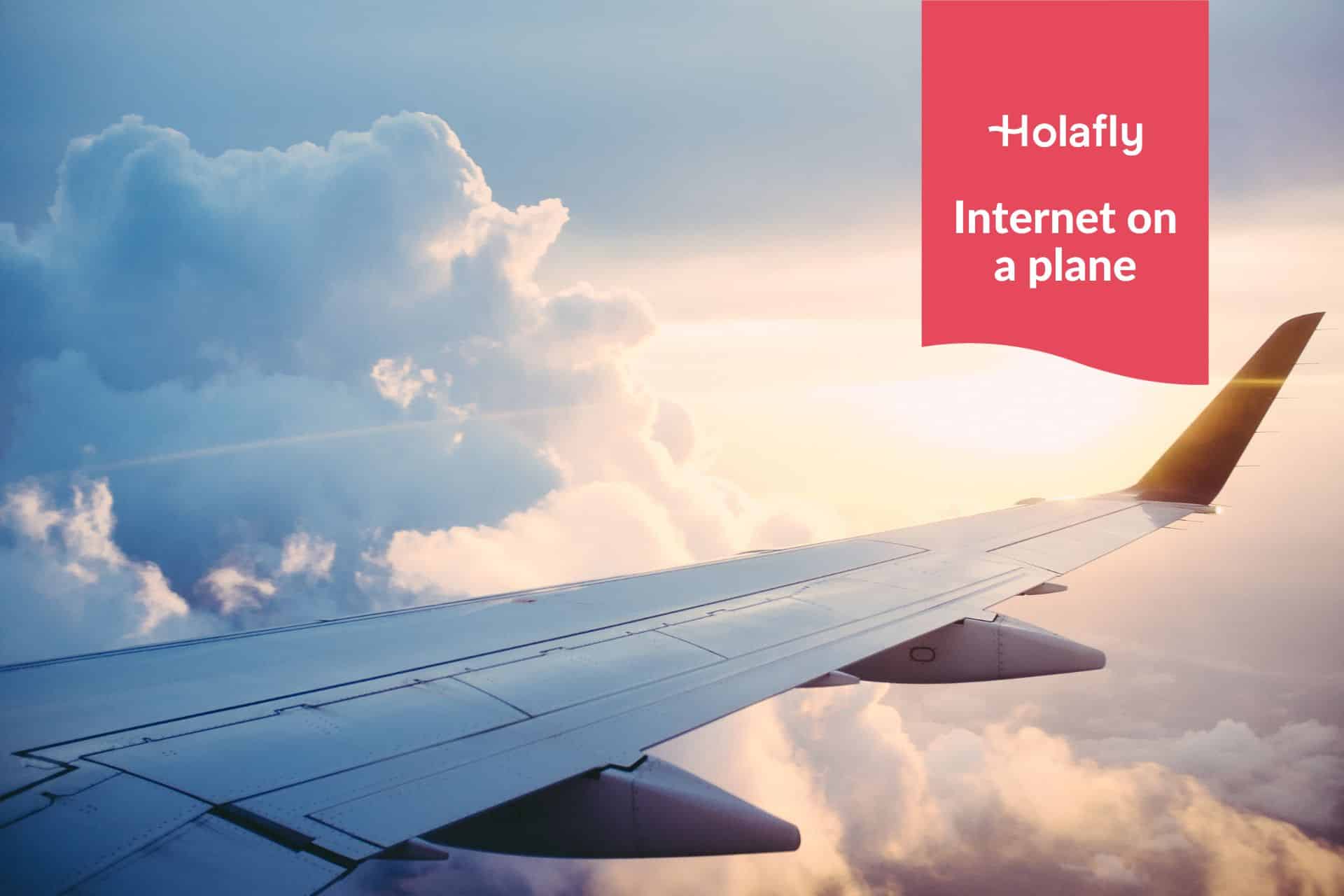Do cell phones work on cruise ships? Everything you need to know
Traveling the seas? Use your phone on a cruise with no issues with on-board internet or an eSIM for the coastal area and live the best experience at sea.
Cruise ships are great for enjoying sunsets — not so much for catching phone signals.
Once you’re out at sea, the signal strength drops quickly, roaming charges can sneak up on you, and cruise WiFi isn’t always reliable — or cheap.
The last thing you want is to post one vacation selfie and end up with a bill bigger than your bar tab.
In this article, we break down the essentials: when your phone can connect, what roaming really means at sea, and alternative ways to stay online without draining your wallet.
Do phones work on cruise ships?
Yes, but they work differently than on land. Your phone can connect through either the ship’s maritime cellular network or WiFi, each with its own costs and limitations.
- Maritime cellular networks: If you leave airplane mode off and enable roaming, your phone will connect to networks like “Cellular at Sea.” Calls, texts, and data work as they do on land but are transmitted via satellite, resulting in higher fees.
- Using WiFi: To avoid roaming fees, switch to airplane mode and rely on the cruise’s WiFi. Cruise lines offer WiFi packages ranging from basic messaging plans to premium options for streaming and video calls.
But how exactly does your phone work on a cruise? Let’s break down the mechanics of cell service and phone connectivity at sea — and how to make the most of it without racking up a massive bill.
| 🛳️Pack a portable charger to keep your phone powered and ready for all those cruise-day updates. For a list of must-have items, check out our cruise packing guide. |
How cell phones work on cruise ships
At sea, cruise ships rely on maritime cellular networks supported by satellite technology, which provides coverage far from land-based cell towers. Here’s how it works:
- When the ship is far from shore, your phone automatically switches to a maritime network like Wireless Maritime Services (WMS) or Cellular at Sea. These networks serve multiple cruise lines, such as Carnival, Royal Caribbean, and Norwegian.
- The maritime network transmits your calls, texts, and data through satellites orbiting the Earth. Signals travel from the ship to the satellite and back to your service provider on land, allowing communication in the middle of the ocean.
- On your phone, the network may appear as “Cellular at Sea” or “901”. To use the service, turn airplane mode off and enable roaming. Your phone will function just like it does on land, though with satellite-based technology.
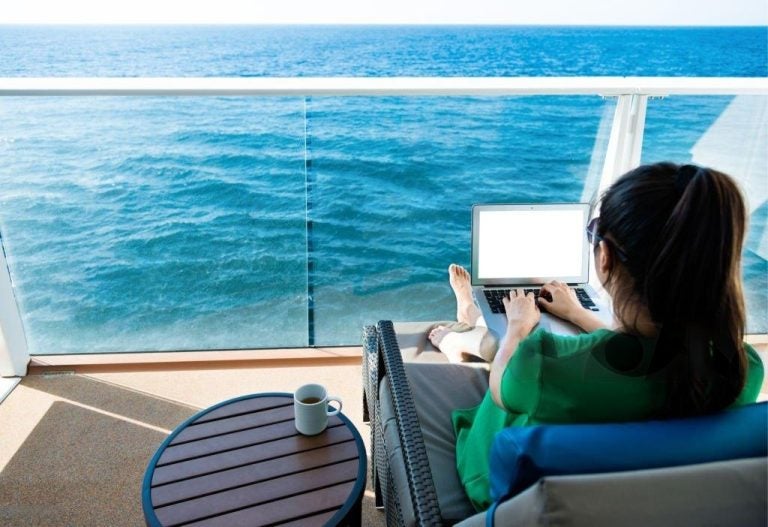
Do cruise ships block phone signals?
Cruise ships don’t intentionally block phone signals, but several factors can interfere with your connection.
- The ship’s design plays a role — thick metal walls, multiple decks, and interior spaces can weaken or completely block signals, especially in areas like interior cabins or lower decks.
- Cruise lines manage their networks to ensure fair usage among passengers. This means restricting access to high-bandwidth services like streaming, which might feel like intentional blocking but is actually to prevent network congestion.
- When the ship moves between international waters and port stops, phones may temporarily lose connection as they switch between maritime and local networks. These disruptions aren’t due to deliberate blocking but rather physical limitations, remote locations, and network management.
Should you put your phone in airplane mode on a cruise?
Yes, it’s a smart idea to put your phone in airplane mode when you board a cruise ship. This prevents your phone from automatically connecting to expensive maritime networks without you realizing it.
Even if you don’t make calls or use apps, background processes can still use data, leading to high roaming fees.
In airplane mode, you turn off your phone’s cellular connection but can still use WiFi and Bluetooth. This allows you to connect to the ship’s WiFi for browsing, using messaging apps like WhatsApp, or accessing the cruise line’s app for onboard services.
Some ships also support WiFi calling, letting you make phone calls over the internet without using a mobile network.
If you need to connect to local networks at a port stop, you can temporarily turn off airplane mode. Just remember to switch it back on before the ship sets sail to avoid unwanted charges.
How to avoid cell phone charges on cruise ships
We’ve already covered how airplane mode helps prevent your phone from connecting to costly maritime networks. But here are a few more ways to keep your phone bill under control while cruising:
- Buy a cruise WiFi package: Most cruise lines offer WiFi plans that allow you to browse, message, and call over the internet. We’ll cover these packages in detail in the next section to help you choose the best option for your needs.
- Disable data roaming: Go to your phone settings and turn off data roaming to prevent background apps from using data without your knowledge. This step is especially helpful if you leave airplane mode off while at port stops.
- Connect to local networks at ports: When your ship docks, your phone will often switch to local networks. This is a great opportunity to use a regional eSIM with multi-country coverage that can keep you connected without high roaming fees. Providers like Holafly offer regional eSIMs that work across multiple destinations, making it an affordable option compared to pricey maritime networks. This way, you stay connected seamlessly across port stops.
- Use offline apps and content: Download books, music, and movies before your trip so you don’t need to stream content over WiFi or mobile networks. This minimizes internet usage while keeping entertainment at hand during your cruise.
Now that we’ve covered ways to avoid cell phone charges, let’s look at the best options for internet access on cruise ships.
What are the options for onboard internet access?
Cruise ships offer several ways to stay connected online, with various packages to suit different needs. Here’s what you can expect:
1. Ship-based WiFi
Cruise ships offer various WiFi packages, with prices and features varying by cruise line and package type.
- Basic plans: Designed for light use like social media and messaging apps (e.g., WhatsApp, Facebook). Typically costs around $5 to $15 per day.
- Browsing plans: Offers web access and email. Streaming services are often blocked. Prices range from $10 to $20 per day.
- Premium unlimited access: Provides faster speeds for streaming, video calls, and uploads. Costs range between $25 and $40 per day.
However, these prices vary depending on the cruise line. Some ships may include WiFi in all-inclusive packages, while others offer day passes for occasional access.
It’s also common to find discounts for pre-purchasing packages before boarding, often saving up to 10%. Loyalty programs or returning guest incentives sometimes offer special WiFi deals, reducing overall costs.
2. Satellite internet
As mentioned earlier, cruise ships rely on satellite networks to keep phones and internet services running while at sea. Many cruise lines now use providers like SpaceX’s Starlink to improve speeds and reduce latency.
Unlike traditional geostationary satellites that orbit farther from Earth, low-Earth orbit (LEO) satellites like Starlink offer faster, more stable connections.
Several cruise lines, including Carnival, Royal Caribbean, and MSC Cruises, have adopted Starlink to enhance onboard connectivity. However, some ships still use satellite providers like Intelsat and SES Networks to ensure coverage in remote regions.
These systems allow ships to provide internet access far from shore, though weather and network congestion may still affect performance.
3. Mobile hotspots
A mobile hotspot works by sharing your phone’s cellular data connection with other devices, like laptops or tablets.
However, once a cruise ship moves beyond the range of land-based cell towers, your phone’s hotspot becomes ineffective (unless it connects to the ship’s maritime cellular network).
While cruise ships don’t intentionally block personal mobile hotspots like portable WiFi devices or pocket WiFi, the lack of traditional cell tower access at sea renders them unusable.
4. Dedicated spaces
If you’re looking for a quiet and reliable spot to stay connected, cruise ships often provide dedicated spaces like internet cafés or WiFi lounges. These areas typically offer computers and stronger internet connection than other parts of the ship.
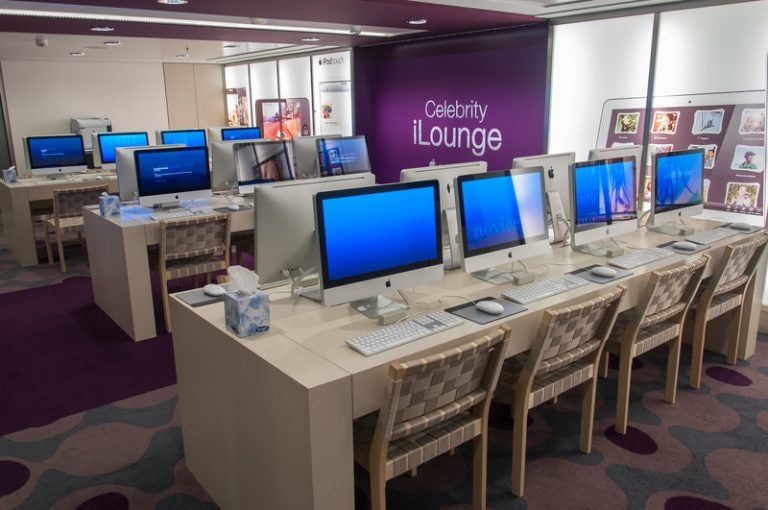
Source: ID 43930024 © Pressfoto | Dreamstime.com
Designed to minimize disruptions, these spaces are perfect for catching up on work. Some ships also use these areas to provide access to the onboard intranet, where you can browse cruise schedules, make reservations, or view activities without needing an internet package.
Now that you know the different ways to access the internet onboard, let’s explore which cruise lines offer internet services and what you can expect from them.
Which cruise lines offer internet services?
From basic messaging packages to premium streaming plans, each cruise line offers something different — let’s take a look!
Carnival Cruise Line
Carnival Cruise Line offers three internet plans tailored to different levels of usage, with up to 15% savings if booked in advance.
- Social Plan: Starting at $12.75 per day (or $15 onboard), this plan gives you access to social media apps like Facebook, WhatsApp, and Instagram.
- Value Plan: Priced at $19.55 per day when booked in advance ($23 onboard), it allows web browsing, email access, and news updates, but blocks streaming services and video conferencing apps like Netflix, Zoom, or Skype.
- Premium Plan: At $21.25 per day when booked early (or $25 onboard), this plan offers faster speeds and access to streaming services. However, speeds may still slow during peak times due to shared bandwidth across the ship.
Carnival also offers a multi-device premium plan for $75 per day, supporting up to four devices — ideal for families or groups traveling together.
Carnival has equipped nearly 12 ships with Starlink, including Carnival Celebration, Carnival Elation, Carnival Magic, and Carnival Vista.
Note: Some passengers report slow speeds, with simple text and graphics pages taking minutes to load, and YouTube videos frequently buffering.
Services like Hulu are actively blocked, and many Reddit users in this thread question the cost-benefit ratio, especially for those who only need brief daily access.
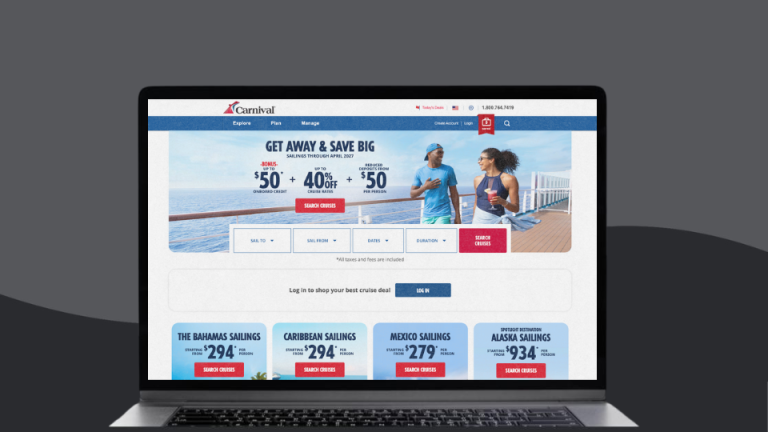
Disney Cruise Line
Even with Mickey’s magic, Disney Cruise Line’s internet options have some limitations, especially when it comes to streaming. Disney offers three packages, but none of them support long-form video streaming, like Netflix or Hulu.
Here’s a breakdown of the options onboard:
- Stay Connected Package: Priced at $16 per day when purchased for the full voyage or $18 per day when purchased for 24 hours. Allows posting text and pictures on social media platforms.
- Basic Surf Package: $24 per day for the full voyage or $28 per day for 24 hours. Includes web browsing, email access, and audio calls.
- Premium Surf Package: $34 per day for the full voyage or $42 per day for 24 hours. Supports music streaming, short-form videos, and video calling.
You can manage these plans through the Disney Cruise Line Navigator App, which also provides access to onboard schedules and reservations.
The app makes it easy to switch devices, but only one device can be logged in at a time.
Note: Some Reddit users in this thread advise against attempting remote work during a cruise. Video calls, particularly Zoom meetings, are reportedly extremely difficult or impossible.
Another Reddit user mentioned that Disney Cruise Line uses deep packet inspection to block VPNs, which can pose challenges for accessing work resources securely.
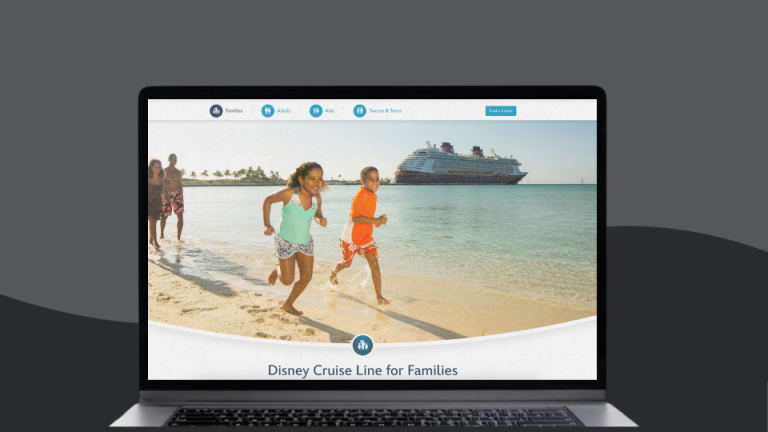
Royal Caribbean International
Royal Caribbean’s internet services at sea are powered by VOOM Surf & Stream packages.
The cruise line offers two main types of internet packages:
- Surf Package: Priced at $15.99 per device per day, this plan includes basic browsing, email, and social media use.
- Surf + Stream Package: For $19.99 per device per day, this plan includes video streaming, video calls, and faster browsing speeds.
Prices may vary depending on the specific cruise and when you purchase the package. VOOM packages can be bought individually or for the entire trip, with discounts available for pre-booking.
Newer ships like Oasis, Quantum, or Icon Class generally offer better connectivity, as they have been upgraded to SpaceX Starlink.
Note: Some Reddit users in a thread report that Royal Caribbean staff provide a disclaimer that WiFi isn’t guaranteed to work in cabins.
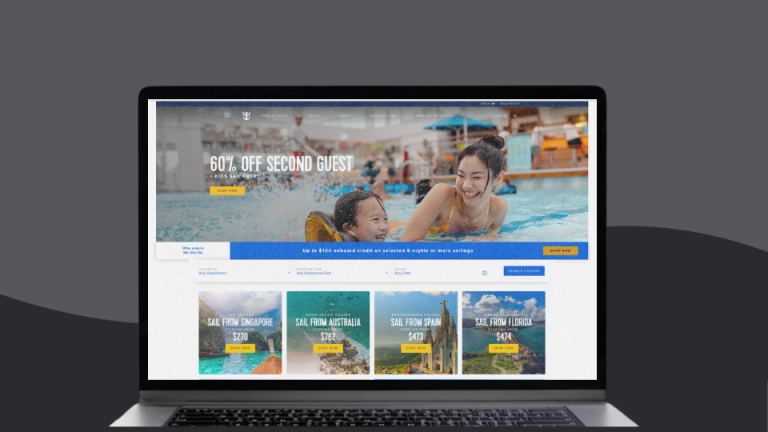
Stay connected on your trip with Holafly eSIM
Staying connected on a cruise requires some planning, as your phone behaves differently depending on your location.
At port or near the coast, your phone can connect to local networks, making options like Holafly’s Global eSIM ideal for easy connectivity without the hassle of swapping SIM cards.
Holafly offers unlimited data plans across 200+ destinations, including regional plans — ideal for cruises spanning multiple countries or continents.
Whether your ship docks in Europe, the Caribbean, or Asia, your eSIM will automatically connect to local carriers at each port.
Simply download the Holafly app (available for Android and iOS), choose your destination, set the duration, and buy your plan.
With a combination of WiFi at sea and eSIM plans like Holafly on land, you can stay connected without worrying about extra charges.
| Stay connected wherever your cruise takes you. Grab your Holafly eSIM today! |





 Language
Language 


















 No results found
No results found









